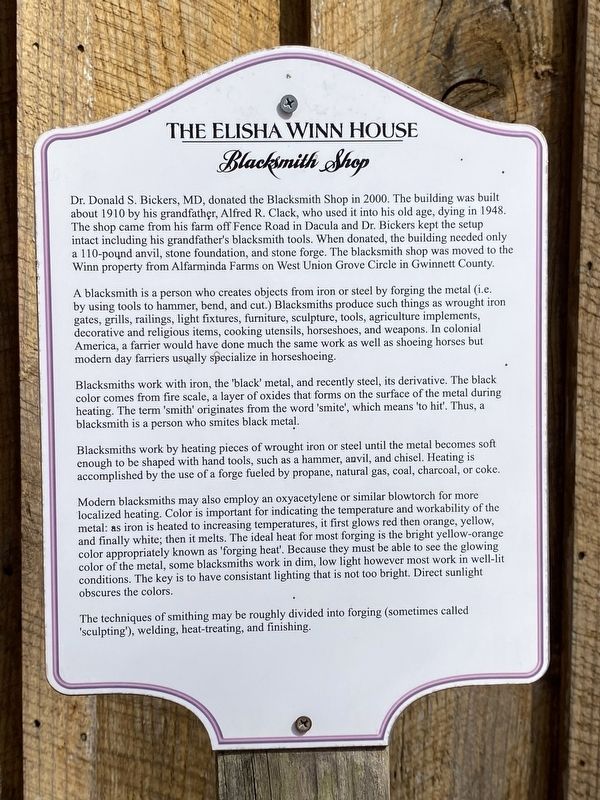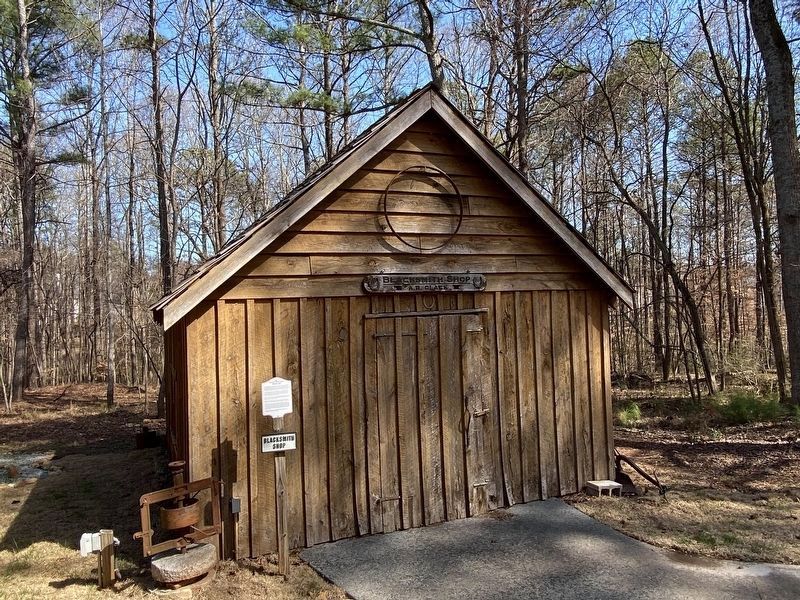Dacula in Gwinnett County, Georgia — The American South (South Atlantic)
The Elisha Winn House
Blacksmith Shop
Inscription.
Dr. Donald S. Bickers, MD, donated the Blacksmith Shop in 2000. The building was built about 1910 by his grandfather, Alfred R. Clack, who used it into his old age, dying in 1948. The shop came from his farm off Fence Road in Dacula and Dr. Bickers kept the setup intact including his grandfather's blacksmith tools. When donated, the building needed only a 110-pound anvil, stone foundation, and stone forge. The blacksmith shop was moved to the Winn property from Alfarminda Farms on West Union Grove Circle in Gwinnett County.
A blacksmith is a person who creates objects from iron or steel by forging the metal (i.e. by using tools to hammer, bend, and cut). Blacksmiths produce such things as wrought iron gates, grills, railings, light fixtures, furniture, sculpture, tools, agriculture implements, decorative and religious items, cooking utensils, horseshoes, and weapons. In colonial America, a farrier would have done much the same work as well as shoeing horses but modern day farriers usually specialize in horseshoeing.
Blacksmiths work with iron, the 'black' metal, and recently steel, its derivative. The black color comes from fire scale, a layer of oxides that forms on the surface of the metal during heating. The term 'smith' originates from the word 'smite', which means to hit. Thus, a blacksmith is a person who smites black metal.
Blacksmiths work by heating pieces of wrought iron or steel until the metal becomes soft enough to be shaped with hand tools, such as a hammer, anvil, and chisel. Heating is accomplished by the use of a forge fueled by propane, natural gas, coal, charcoal, or coke.
Modern blacksmiths may also employ an oxyacetylene or similar blowtorch for more localized heating. Color is important for indicating the temperature and workability of the metal: as iron is heated to increasing temperatures, it first glows red then orange, yellow, and finally white; then it melts. The ideal heat for most forging is the bright yellow-orange color appropriately known as 'forging heat'. Because they must be able to see the glowing color of the metal, some blacksmiths work in dim, low light however most work in well-lit conditions. The key is to have consistent lighting that is not too bright. Direct sunlight obscures the colors.
The techniques of smithing may be roughly divided into forging (sometimes called 'sculpting'), welding, heat-treating, and finishing.
Topics. This historical marker is listed in this topic list: Notable Buildings.
Location. 34° 1.449′ N, 83° 54.495′ W. Marker is in Dacula, Georgia, in Gwinnett County. Marker can be reached from Dacula Road, 0.6 miles
south of Auburn Road (Georgia Route 324), on the left when traveling south. Touch for map. Marker is at or near this postal address: 908 Dacula Rd, Dacula GA 30019, United States of America. Touch for directions.
Other nearby markers. At least 8 other markers are within 2 miles of this marker, measured as the crow flies. A different marker also named The Elisha Winn House (here, next to this marker); a different marker also named The Elisha Winn House (a few steps from this marker); a different marker also named The Elisha Winn House (within shouting distance of this marker); a different marker also named The Elisha Winn House (about 300 feet away, measured in a direct line); a different marker also named Elisha Winn House (about 400 feet away); The Dr. William Hinton House (approx. 1.6 miles away); Stone Structures (approx. 1.6 miles away); Old Oak Tree (approx. 1.9 miles away). Touch for a list and map of all markers in Dacula.
Also see . . . Elisha Winn House. Gwinnett County Parks & Recreation (Submitted on March 6, 2024.)
Credits. This page was last revised on March 6, 2024. It was originally submitted on March 3, 2024, by Darren Jefferson Clay of Duluth, Georgia. This page has been viewed 38 times since then. Photos: 1, 2. submitted on March 5, 2024, by Darren Jefferson Clay of Duluth, Georgia. • Bernard Fisher was the editor who published this page.

